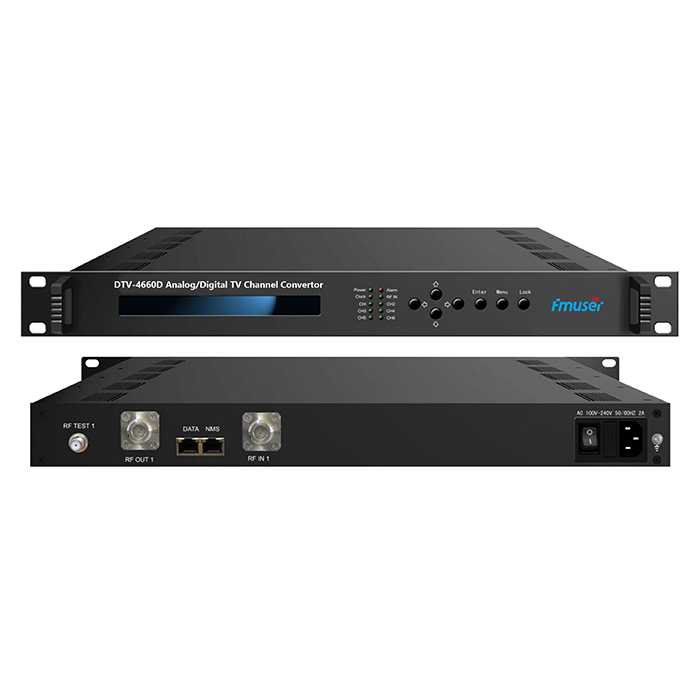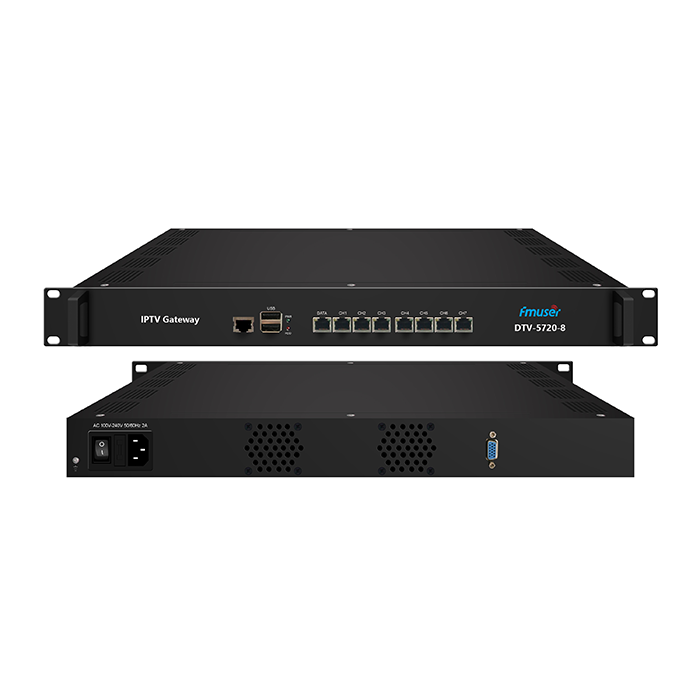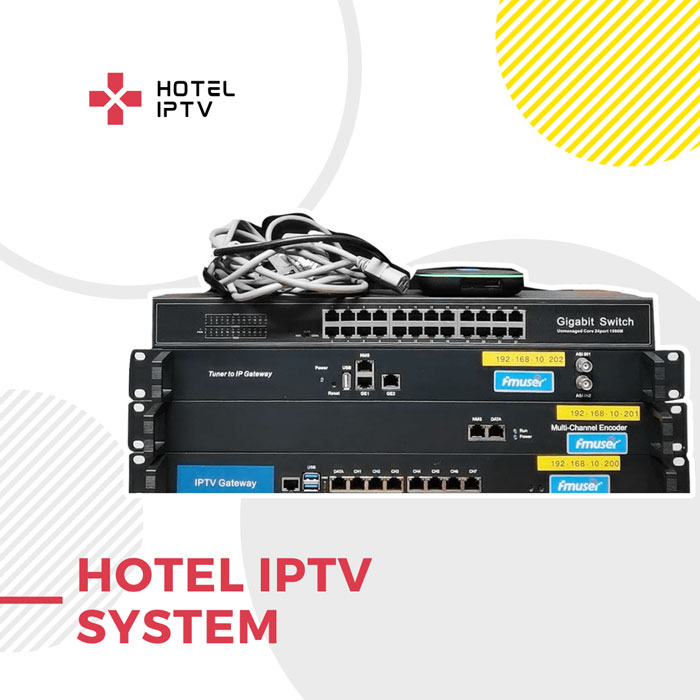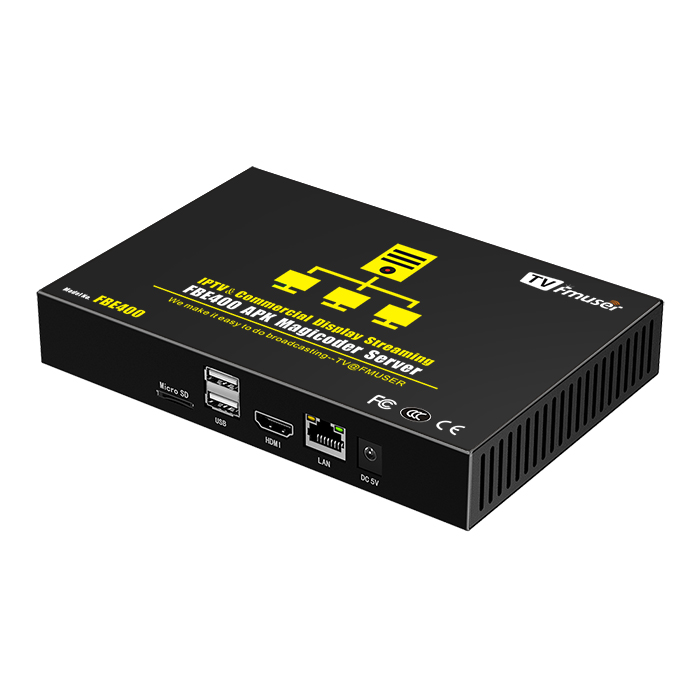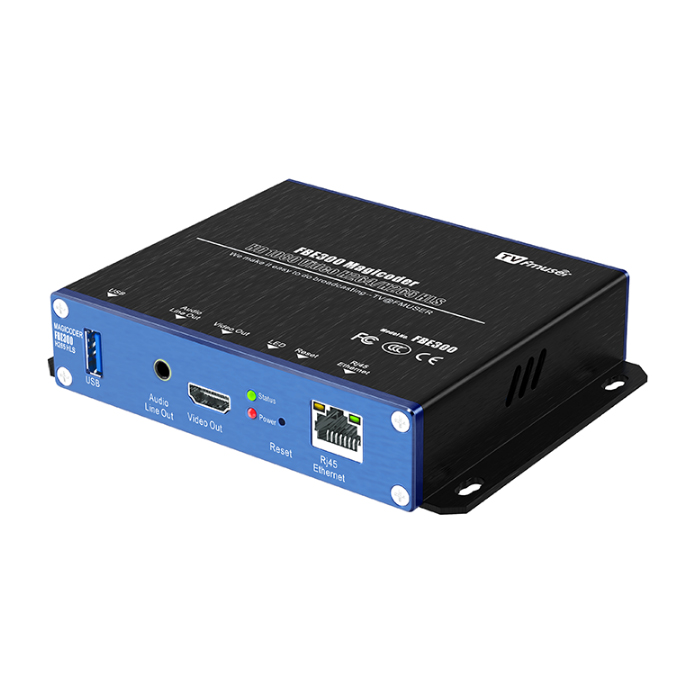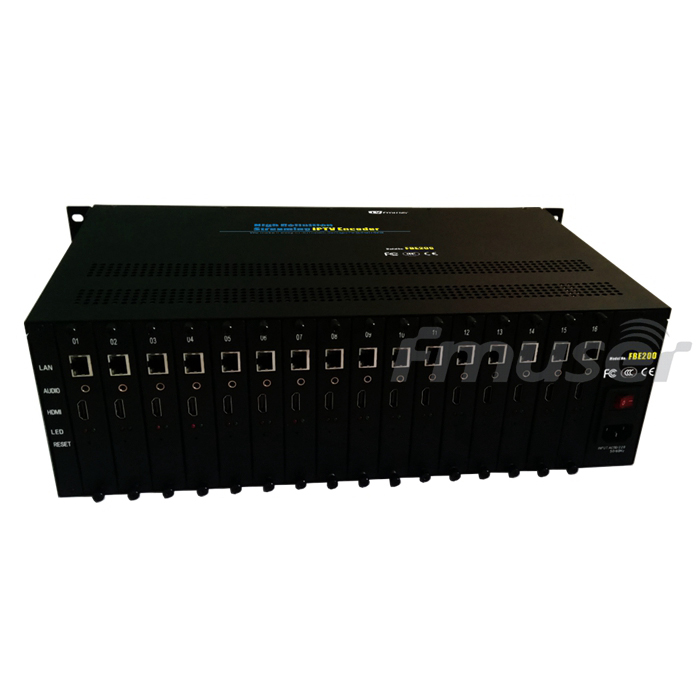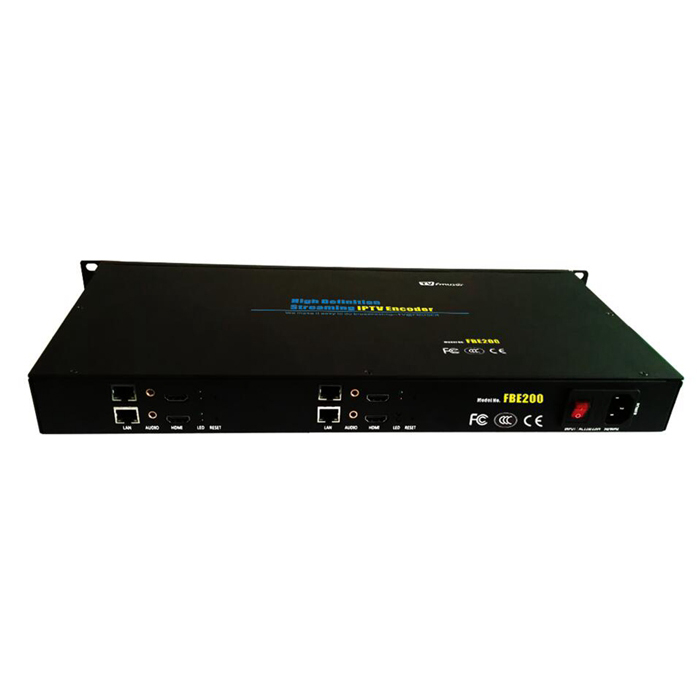
IPTV Headend
IPTV headend equipment is a system of hardware and software that enables operators to encode, encrypt, multiplex, and deliver video and audio streams over an IP network. It consists of video encoders, decoders, modulators, multiplexers, modems, and IRDs (integrated receiver decoders). Headend equipment is used to convert analog signals into digital signals for broadcasting over a network. It also allows for the integration of data services such as VOD (video on demand) and streaming video. This type of equipment is used by telecoms, cable operators, and broadcasters to deliver digital services such as IPTV, HDTV, and streaming video.
FMUSER's pride IPTV headed equipment include dozens of devices designed to support SDI and HDMI audio input interfaces, as well as RTSP/RTP/RTP/UDP/HTTP/TS/RTMP/HLS m3u8 IP protocols. These machines boast powerful functions and features, such as teletext/subtitle/multilingual support, software upgrade, media file playback and video output resolution up to 1080p, making them suitable for streaming media broadcasting systems. With an LCD and NMS (network management software) configured on the device, they are easy to operate and manage. Moreover, they are compatible with most streaming platforms, allowing users to live broadcast on any streaming service, such as WOWZA, FMS, Red5, YouTube Live, Face book live, Ustream, Live stream, Twitch, Meridix, Stream spot, Dacast, Tikilive, and Netrmedia.
Their high integration and cost-effective design make them suitable for a variety of applications, such as professional broadcast level IPTV & OTT systems, hospitality IPTV applications, Remote HD multi-window video conferences, Remote HD education, Remote HD medical treatments, Streaming Live Broadcasts, and many more.
-
![FMUSER DTV4660D Analog/Digital TV Channel Converter for TV Relay Station]()
FMUSER DTV4660D Analog/Digital TV Channel Converter for TV Relay Station
Price(USD):Ask for a quotation
Sold:18
-
![FMUSER 8-Way IPTV Gateway for Hotel IPTV System]()
-
![FMUSER Hospitality IPTV Solution Complete Hotel IPTV System with IPTV Hardware and Management System]()
FMUSER Hospitality IPTV Solution Complete Hotel IPTV System with IPTV Hardware and Management System
Price(USD):Ask for a quotation
Sold:174
-
![FMUSER Complete IPTV Solution for School with FBE400 IPTV Server]()
FMUSER Complete IPTV Solution for School with FBE400 IPTV Server
Price(USD):Ask for a quotation
Sold:121
FMUSER FBE200 is with high integration and cost-effective design make this device widely used in a variety of digital distribution systems, such as the construction of professional broadcast level IPTV & OTT system, hospitality IPTV application, Remote HD multi-window video conference, Remote HD education, and Remote HD medical treatment, Streaming Live Broadcast, etc.
The FMUSER FBE200 H.264/H.265 IPTV Streaming Encoder supports 1 audio and HDMI video collection by input simultaneously for option. You can choose to use the HDMI or 3.5mm stereo for the audio line-in.
Each channel of HDMI input supports 3 IP streams output with two different resolutions (one higher resolution, one lower resolution) for adaptive bitrates, each group of IP stream supports two kinds of IP protocols output (RTSP/HTTP/Multicast/Unicast/RTMP/RTMPS).
FMUSER FBE200 IPTV Encoder can deliver H.264/H.265/encoding video streams with more channels of independent IP output to various servers for IPTV & OTT application, such as Adobe Flash Server (FMS), Wowza Media Server, Windows Media Server, RED5, and some other servers based on UDP/RTSP/RTMP/RTMPS/HTTP/HLS/ONVIF protocols. It also supports the VLC decode.
FBE200 is compatible with most of the streaming platforms, Live Broadcast On Any Streaming Service like WOWZA, FMS, Red5, YouTube Live, Face book live, Ustream, Live stream, Twitch, Meridix, Stream spot, Dacast, Tikilive, Netrmedia...
-
![FMUSER FBE300 Magicoder IPTV H.264/H.265 Hardware Video Transcoder for Live Streaming]()
FMUSER FBE300 Magicoder IPTV H.264/H.265 Hardware Video Transcoder for Live Streaming
Price(USD):Ask for a quotation
Sold:120
As an encoder, the FBE300 can encode video files into IP video streams and push them to the network for use in public digital signage.
As a decoder, the FBE300 can decode IP video streams into HD video for display and online video playback also can be a set-top box for use with a TV.
As a transcoder, the FBE300 can convert IP video streams to other formats/protocols/resolutions and re-stream the converted IP video stream to the network. Widely used in TV operators, telecom operators, system integration, can greatly reduce the cost of system replacement.
As a player, the FBE300 can play video files from HD output in HD or on digital display ads.
-
![FMUSER FBE216 H.264 H.265 16 Channels IPTV Encoder for Live Streaming]()
FMUSER FBE216 H.264 H.265 16 Channels IPTV Encoder for Live Streaming
Price(USD):Ask for a quotation
Sold:101
-
![FMUSER FBE204 H.264 H.265 4-Channel IPTV Encoder for Live Streaming]()
FMUSER FBE204 H.264 H.265 4-Channel IPTV Encoder for Live Streaming
Price(USD):Ask for a quotation
Sold:74
- What is IPTV headend equipment used for?
- The applications of IPTV headend equipment include live TV streaming, video on demand, time-shifting, real-time streaming, recording, and transcoding of content.
- How does IPTV headend system work?
- IPTV headend equipment includes encoders, receivers, modulators, multiplexers, streamers, and transcoders.
Encoders take audio and video signals from a source, such as a satellite receiver or a DVD player, and encode them into a digital format. The encoded signals are then sent to the IPTV network.
Receivers take the encoded signals from the IPTV network and decode them back into audio and video signals.
Modulators take the encoded signals from the IPTV network and modulate them onto a radio frequency. These modulated signals can then be sent over the air or over cable lines.
Multiplexers take multiple input sources, such as audio and video signals, and combine them into one multiplexed signal. This signal can then be sent over the IPTV network.
Streamers take multiplexed signals from the multiplexer and stream them to the IPTV network.
Transcoders take the encoded signals from the streamer and convert them into a different format, such as from MPEG-2 to H.264. This allows the encoded signals to be compatible with different devices.
- Why IPTV headend is important for TV broadcasting?
- IPTV headend equipment is important because it is responsible for receiving and encoding television and other media signals from multiple sources, such as satellite dishes and antennas, and compressing them into streaming media formats for distribution to viewers. This equipment is essential for providing a quality viewing experience for subscribers.
- Why you choose IPTV headend equipment over others?
- The advantages of IPTV headend equipment include increased scalability, cost savings, improved quality of service, and increased access to content. Additionally, IPTV headend equipment allows for more efficient content delivery, improved security, and better integration with existing systems.
- What consists of a complete IPTV headend system?
- There are four main types of IPTV headend equipment: encoders, modulators, multiplexers, and transcoders. Encoders take an analog signal and convert it into a digital format for streaming over the internet. Modulators convert digital signals into radio frequency signals for broadcast over cable or satellite. Multiplexers combine digital signals to create a single transmission stream. Transcoders convert digital signals from one format to another. Each of these types of equipment has different purposes, so the differences between them depend on the specific application.
- How to step-by-step build up an IPTV headend sytem?
- Step 1: Research the various types of IPTV headend equipment available on the market, such as modulators, encoders, multiplexers, streamers, receivers, and set-top boxes.
Step 2: Consider factors such as the type of content you plan to deliver and the number of viewers you plan to serve.
Step 3: Choose a modulator that will enable you to broadcast your content to multiple devices, such as TV sets and computers.
Step 4: Select an encoder to compress your content so that it can be streamed smoothly.
Step 5: Choose a multiplexer to combine multiple streams of data into a single channel.
Step 6: Select a streamer to deliver your content to multiple devices at the same time.
Step 7: Purchase a receiver to receive and decode the data from the streamer.
Step 8: Decide on a set-top box to decode and display the content on a TV set.
Step 9: Compare the features and prices of different headend equipment to make sure you are getting the best value for your money.
Step 10: Test the equipment before placing a final order.
- How to choose the best IPTV headend equipment? Main suggestions
- - For encoders, transcoders, multiplexers and others: Encoding capabilities (especially for encoders), Video output formats, video input formats, video compression, audio compression, video resolution, audio sampling rate, content protection, and support for streaming protocols.
- Receivers: Built-in decoders, HDMI connectivity, MPEG-2/4 decoding, IP multicast compatibility, support for IPTV streaming protocols, and content protection.
- Switches: Bandwidth, port speed, and port count.
- Set-top boxes: Video output formats, video input formats, video compression, audio compression, video resolution, audio sampling rate, content protection, support for streaming protocols, and user-friendly interface."
- How to build up an IPTV headend system for a hotel?
- To build a complete IPTV headend system for a hotel, you will need the following IPTV headend equipment: an encoder, a multiplexer, a transmodulator, a scrambler, a modulator, and a gateway. Additionally, you will need to set up a content management system, IPTV monitoring system, IPTV server, and video on demand server.
- How to build up an IPTV headend system for a cruise ship?
- To build up a complete IPTV headend system for a cruise ship, you will need the following equipment: a satellite receiver, a digital encoder, an IPTV streaming server, an IPTV media gateway, an IPTV middleware server, an IPTV headend controller, and a network switch. Additionally, you will need an IPTV set-top box for each cabin on the ship.
- How to build up an IPTV headend system for a prison?
- To build up a complete IPTV headend system for a prison, you will need the following IPTV headend equipment:
1. Multicast IPTV encoder: This is used to encode and transcode content from different sources into IPTV streams.
2. High-speed internet connection: This is necessary to ensure reliable streaming of content to the prison.
3. Set-top boxes (STBs): These are used by the prison inmates to access the IPTV service.
4. Video servers: These servers store the content and provide it to the STBs.
5. Management software: This is used to control and monitor the IPTV system.
6. IPTV headend system: This is the main component of the IPTV headend that ties everything together and provides the necessary control, management, and monitoring of the system.
- How to build up an IPTV headend system for a hospital?
- To build up a complete IPTV headend system for a hospital, you will need the following IPTV headend equipment: an encoder, a content delivery network (CDN) server, a streaming media server, a content management system (CMS), a digital rights management (DRM) system, and a media gateway.
- What else equipment do I need for a complete hotel IPTV system?
- In order to build a complete hotel IPTV system, you will need a cable modem, a network switch, a router, a media gateway, an IPTV middleware server, a set-top box, and a remote control.
A cable modem is needed to connect to the internet and provide internet access to the IPTV system. A network switch is necessary to connect all the components of the system together. A router is needed to manage traffic between the LAN and the WAN. A media gateway is needed to bridge the IPTV headend and the IPTV middleware server. An IPTV middleware server is needed to manage the delivery and playback of content on the IPTV system. A set-top box is needed to provide access to the IPTV services to the end user. Finally, a remote control is needed to control the set-top box and access the IPTV services.
- What else equipment do I need for a complete prison IPTV system?
- You will need a variety of additional equipment to complete a prison IPTV system. This includes:
- Network Switches: Used to connect all components of the system together and allow information to flow between them.
- Network Storage: Used to store content that can be accessed by IPTV clients.
- Servers: Used to manage and stream content to IPTV clients.
- Set-Top Boxes: Used to decode and display the video content from the IPTV system.
- Video Encoders: Used to compress and encode video content so it can be streamed over the IPTV system.
- Cabling: Used to connect all components of the system together.
- Remote Control Units: Used to allow users to control the IPTV system from a distance.
All of these pieces of equipment are necessary to ensure that your prison IPTV system is able to stream content to users reliably and securely.
- What else equipment do I need for a complete cruise ship IPTV system?
- In addition to the IPTV headend equipment, you will need other equipment to build a complete cruise ship IPTV system. This includes network equipment such as switches and routers, media servers, and set-top boxes. You will also need cabling and connectors to connect these components together.
Switches and routers are needed to create a local area network (LAN) that will allow the IPTV headend equipment to communicate with the rest of the system. Media servers are needed to store and distribute video content to the set-top boxes. Set-top boxes are needed to decode and display the video content for each user. The cabling and connectors are needed to physically connect all the components of the system together.
- What else equipment do I need for a complete hospital IPTV system?
- To build a complete hospital IPTV system, you will need the following equipment in addition to the IPTV headend equipment:
1. Network switches: These are necessary for creating a network that can transmit the IPTV signals from the headend to the various TVs across the hospital.
2. Set-top boxes: These devices are used to receive the IPTV signals and decode them for viewing on the TVs.
3. IP cameras: These are used to capture video footage and stream it to the IPTV system.
4. Video processing equipment: This is necessary for compressing and formatting the video footage for streaming on the IPTV system.
5. Encoders and decoders: These are used to encode and decode the IPTV signals so they can be transmitted and received by the IPTV system.
6. Remote control devices: These are necessary for controlling the IPTV system remotely.
7. Monitors and televisions: These are used to view the IPTV signals.
- How are you?
- I am fine
CONTACT US


FMUSER INTERNATIONAL GROUP LIMITED.
We are always providing our customers with reliable products and considerate services.
If you would like to keep touch with us directly, please go to contact us
